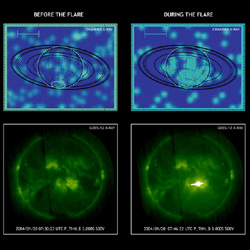May 25, 2005
NASA RELEASE 05-134
When it comes to mysterious X-rays from Saturn, the ringed planet may act as a mirror, reflecting explosive activity from the sun, according to scientists using NASA's Chandra X-ray Observatory. The findings stem from the first observation of an X-ray flare reflected from Saturn's low-latitudes - the region that correlates to Earth's equator and tropics.
Led by Dr. Anil Bhardwaj, a planetary scientist at NASA's Marshall Space Flight Center (MSFC) in Huntsville, Ala., the study revealed that Saturn acts as a diffuse mirror for solar X-rays. Counting photons - particles that carry electromagnetic energy including X-rays - was critical to this discovery. For every few thousand X-ray photons Saturn receives from the sun, it reflects a single X-ray photon back.
Previous studies revealed that Jupiter, with a diameter 11 times that of Earth, behaves in a similar fashion. Saturn is about 9.5 times as big as Earth, but is twice as far from Earth as Jupiter. "The bigger the planet and nearer to the Sun, the more solar photons it will intercept - resulting in more reflected X-rays," said Bhardwaj.
"These results imply we could use giant planets like Jupiter and Saturn as remote-sensing tools. By reflecting solar activity back to us, they could help us monitor X-ray flaring on portions of the sun facing away from Earth's space satellites."
Massive solar explosions called flares often accompany coronal mass ejections, which emit solar material and magnetic field. When directed toward the Earth, these ejections can wreak havoc on communication systems from cell phones to satellites.
Even as the research appears to have solved one mystery - the source of Saturn's X-rays, it fueled longstanding questions about magnetic fields. Earth's magnetic field is the reason compasses work, since the field acts like a huge bar magnet, causing the magnetic north pole of a compass to point to the magnetic south pole of the Earth. In addition, migratory birds seem to sense the magnetic field, which allows them to navigate. But other affects of magnetic fields, only recently studied in detail, are obvious only to those living at Earth's high latitudes, or to those observing the Earth from space.
Of the three magnetic planets in our solar system that have been studied extensively, Jupiter and Earth emit two general types of X rays -- auroral emissions from polar regions and disk emissions from low latitudes. However, no research to-date - including the recent study using the Chandra Observatory - has observed unambiguous signatures of auroral X-ray emissions on Saturn. "We were surprised to find no clear evidence of auroral X-ray emissions during our observations," said Bhardwaj. "It is interesting to note that even as research solves some mysteries, it confirms there is much more we have to learn.
The research appeared in the May 10, 2005 issue of Astrophysical J. Letters, and the team also included Ron Elsner of MSFC; Hunter Waite of the University of Michigan in Ann Arbor; Randy Gladstone of the Southwest Research Institute in San Antonio, Texas; Thomas Cravens of the University of Kansas in Lawrence and Peter Ford from the Massachusetts Institute of Technology in Cambridge.
Bhardwaj is working at MSFC on leave from the Space Physics Laboratory of the Vikram Sarabhai Space Centre in India. The Marshall Center manages the Chandra program for NASA's Science Mission Directorate in Washington. Northrop Grumman of Redondo Beach, Calif., was the prime development contractor for the observatory. The Smithsonian Astrophysical Observatory controls science and flight operations from the Chandra X-ray Center in Cambridge, Mass.
Additional information and images are available at:
MEDIA CONTACTS
Erica Hupp
Headquarters, Washington, DC
(Phone: 202-358-1237)
Steve Roy
Marshall Space Flight Center, Huntsville, AL
Phone: 256-544-6535
Megan Watzke
Chandra X-ray Center, Cambridge, MA
Phone: 617-496-7998



